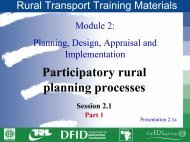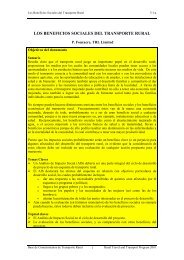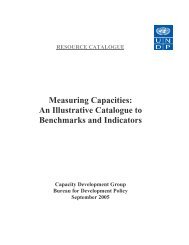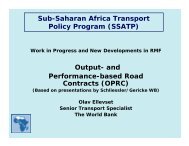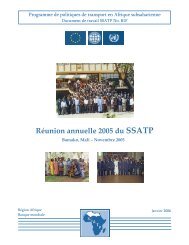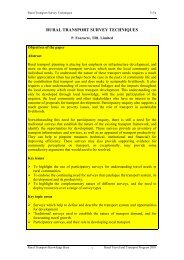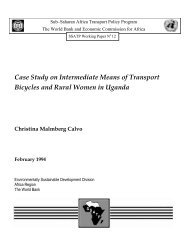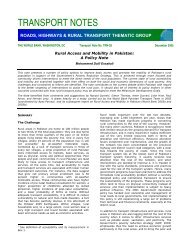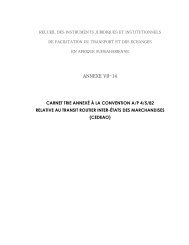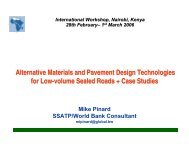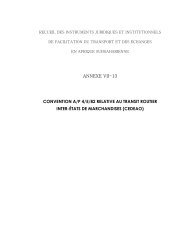annexe v-4 1985 northern corridor transit agreement - World Bank
annexe v-4 1985 northern corridor transit agreement - World Bank
annexe v-4 1985 northern corridor transit agreement - World Bank
Create successful ePaper yourself
Turn your PDF publications into a flip-book with our unique Google optimized e-Paper software.
Customs seals and fastenings affixed by theCustoms authorities of the other NorthernCorridor States, or of a third country. Suchseals and fastenings may, however, have to bereplaced by national ones under certainconditions.In order to place national and foreign Customsseals and fastenings on an equal footing, asprovided for in this Article, the latter shall beafforded the same legal protection as theformer. This means, inter ah, thatunauthorized breaking of foreign seals andfastenings should entail the same legalconsequences as the unauthorized breaking ofnational seals and fastenings.SECTION 2details on the Goods declaration. Physicalexamination of the goods for idmtificationpurposes should be carried out on the basis ofrandom checks only unless there is reason tosuppose that all is not in order.. Article 14Paragraph 4 of this Article applies, inparticular, to the transport ofheavy and bulkygoods (such as motor cars and large machines)which @“cannot be carried in sealedtransport-units. This constitutes an exceptionto the principle that each vehicle should besealed. The heavy or bulky goods carried andany accessories carried with them can then beeasily identified by reference to the descriptiongiven, or can be provided with Customs sealsand/or identifying marks so as to prevent anysubstitution.-.Office of departureThe Office of departure is defined as anyCustoms Office at which a Customs <strong>transit</strong>operation commences. It is at this CustomsOffice that the goods together with the relevantdocuments have to be presented to theCustoms authorities. The latter, in turn, arerequired to carry out certain checks and to takecertain measures, e.g. to seal the goods or thetransport-unit before authorizing the goods toleave under Customs <strong>transit</strong>.For the purposes of Customs <strong>transit</strong> operationscarried out under this Protocol, the OfFice ofdeparture may be situated in the territory ofany of the Contracting Parties. In manyinstances it will be left to the declarant todecide where to commence the <strong>transit</strong>operation. In others, however, such as the casewhere the goods to be carried under Customs<strong>transit</strong> are entitled to drawback or otherrepayment when exported, the Customsauthorities will normally require the Customs<strong>transit</strong> operation to commence in their ownterritory so that the necessary control measurescan be taken. In other cases, the Customsauthoritiss will require goods which areimported mto their country en route to anotherContracting Party to be placed under Customs<strong>transit</strong> at once.Article 13When verifying the facts referred to inparagraph 2 of this Article, the Customsauthorities check the marks and numbers ofpackages and their number and kind against theSECTION 3Article 16In normal cases there is no need for theCustoms Offices en route to examine the goods;it is usually sufficient for these Offices to carryout the control measures described in thisArticle.The entrance Offride en route will send back tothe Office en route at the exit of the precedingcountry one copy of the goods declarationstamped. This Office sends then back to theentrance Office en route or Office of departureone copy of the goods declaration, which willcertify the goods have left the country, the<strong>transit</strong> operation has been normally carried outand the security bond can now be cancelled.Article 17Depending upon the nature and direction of thetrafftc, the Office of destination may be situatedin the territory of either Contracting Party.The examination of the goods may take place,for example, when they are placed underanother Customs procedure, e.g. under theCustoms warehousing procedure, or when theyare transferred to another means of transportfor exportation.According to paragraph 2 of this Article, theOflice of destination returns a copy of theGoods declaration, duly endorsed, to the
-:: x.,:._‘1,.. .with paragraph 2 below. they shall return that (,a, Any available information relating tocopy to the Office of departure, or - in <strong>transit</strong>Goods declarations completed orcountries - to the OfIice en route where the accepted in their territory which aregoods entered the Customs territory. suspected of being false:3 A. At offices where goods are imported into theCusroms tevvitovy, the Customs authorities shallsatisfy themselves that the Goods declarationis in order, that any Customs seals andfastenings or identification marks previouslyaffixed are intact and, where appropriate, thatthe transport-unit is secure, and that theguarantee is in force; they shall then endorsethe Goods declaration accordingly, retain onecopy and return one copy to the Ofice en routein the Customs territory from which the goodswere imported.3. When an Oflice en route removes aCustoms seal or identification mark, forexample, when they are no longer consideredto be secure, it shall record details of the newCustoms seals or identification marks on theGoods declaration accompanying the goods.(b) Any available information enablingthe authenticity of seals claimed tohave been affixed in their territory tobe verified..Article 19: Notificationof inaccuraciesThe Customs authorities of theContracting Parties shall, spontaneously andwithout delay, notify each other of any seriousinaccuracy in a Goods declaration or of anyother serious irregularity discovered inconnexion with a Customs <strong>transit</strong> operationcarried out under the provisions of thisProtocol, in order that the matter may beinvestigated, any duties and taxes chargeablemay be collected and any repetition of thecircumstances may be prevented.Article 17: Formalities at the Office ofdestination l1. At the Office of destination, the Customsauthorities shall satisfy themselves that anyseals and fastenings or identification marks areintact and verify that the transport-unit isotherwise secure. They may also carry outeither a summary or a detailed examination ofthe goods themselves.2. After having satisfied themselves that allobligations relating to the Customs <strong>transit</strong>operation have been fulfilled, the Customsauthorities at the Office of destination shallendorse the Goods declaration accordingly.They shall also send a copy of the Goodsdeclaration back to the appropriate Customsoffice so as to allow the authorities of the latterto take any action, documentary or otherwise,necessary for the completion of the Customs<strong>transit</strong> operation. ...*SECTION 4. MUTUAL ADMINISTRATIVEASSISTANCEArticle 18: Communicationof informationThe Customs authorities of theContracting Parties shall, on request,communicate to each other as promptly aspossible:SECTION 5. STORAGE FACILITIESArticle 20: Pert&ionin <strong>transit</strong>to store goodsThe Contracting Parties shall allow goodsconsigned from or destined to the territory ofother Contracting Parties, to be stored in theirterritory, either in a temporary store or in aCustoms warehouse, where such storage isnecessary either after or before a Customs<strong>transit</strong> operation or at any stage in the courseof such an operation, for example, at a frontierpost, for a period sufficient to enable the goodsto be forwarded to their ultimate destination ina third country or to be placed under Customs<strong>transit</strong>.Article 21: Operations permitted for goods stored1. Stored goods shall be allowed to undergonormal operations necessary for theirpreservation in good condition. Suchoperations include cleaning, beating, removalof dust, sorting and repair or change of faultypackings.2. Goods shall also be allowed to undergonormal operations necessary to facilitate theirremoval from their place of storage and theirfurther transport. Such operations includepiling, weighing, marking and labelling.lc
Article 22: Documents to cover storage lWhen arriving at the place of store, goodsshall be accepted in temporary store undercover of the commercial or transport documentaccompanying them, for example, a Cargo. manifest, Multimodal transport document, Billof lading, Air waybill or a Goods declarationfor Customs <strong>transit</strong>. Goods placed in aCustoms warehouse shall comply with thenational Customs warehousing procedure.ArticleSECTION6. MISCELLANEOUS23: Priority to certain consignmentsThe Contracting Parties shall grant, atany Customs office where Customs clearancetakes place during a Customs <strong>transit</strong> operation,priority to consignments consisting of liveanimals, perishable goods and of other urgentlyneeded goods for which rapid transport isessential.Article 24: DangerousgoodsTransport of dangerous goods underCustoms <strong>transit</strong> shall be governed by theprovisions of Article 31 of the NorthernCorridor Transit Agreement, and the ProtocolNo. 7 to this Agreement on the Handling ofdangerous goods.Article 25: AccidentsAccidents and other unforeseen events enroute affecting the Customs <strong>transit</strong> operationshall be reported to, and verified by, theCustoms or other competent authorities closestto the scene of the accident or other unforeseenevent.Article 26: Lost goods1. The Contracting Parties shall grantexemption from the payment of the importduties and taxes normally chargeable, when itis established to the satisfaction of the Customsauthorities that goods consigned from or to theterritor)l_ of another Contracting Party andbeing transported under Customs <strong>transit</strong>, havebeen destroyed or are irrecoverably lost byaccident or by force majeure, or are short forreasons due to their nature.2. Remnants of such goods may be:(a>(b)(cl(4Cleared for home use in their existingstate as if they had been imported inthat state; orRe-exported;orDestroyed or rendered commerciallyvalueless under Customs controlwithout expense to the Revenue; orWith the consent of the Customsauthorities, abandoned free of allexpenses to the Revenue.Article 27: Review of the implementationprovisions of this Protocolof theRepresentatives of ’ the CustomsAdministrations of the Contracting Partiesshall meet at least once a year or upon therequest of a Contracting Party or the TransitTransport Co-ordination Authority through itsSecretariat to monitor the implementation ofthe provisions of this Protocol.-6-
Annex I to Protocol No. 3IMINI.MUM REQUIRWIESTS TO BE MET BY CUSTOMS SEALS AND FASTEh’INGSCustoms seals and fastenings shall meet thefollowing minimum requirements:I. General requirements in respect of sealsand fastenings:The seals and fastenings, together, shall:(a>@I(c)(4(e>(0be strong and durable;be capable of being affrxed easily andquickly;be capable of being readily checkedand identified;not permit removal or undoingwithout breaking or tamperingwithout leaving traces;not permituse more than once;be made as difficult as possible tocopy or counterfeit.2. Physical specification of seals:(a)(b)the shape and size of the seal shall besuch that any identifying marks arereadily legible;each eyelet in a seal shall be of a sizecorresponding to that of the fasteningused, and shall be positioned so thatthe fastenings will be held firmly inplace when the seal is closed;(c) the material used shall be sufficiently5. strong to prevent accidental breakage,early deterioration (due to weatherconditions, chemical action, etc.) orundetectable tampering.3. Identification marks:The seal or fastenings, as appropriate, shall bemarked:(4(b)(clto show that it is a Customs seal, byapplication of either of the words“Customs” or “Douane”;to show the country which applied theseal, preferably by means of the signused to indicate the country ofregistration of motor vehicles ininternational traffic;to enable the Customs oflice by whichthe seal was affixed, or under whoseauthority it was affixed, to beidentified, for example, by means ofcode letters or numbers.,-
Annex II to Protocol No. 3LIST OF IXTERNATIONAL INSTRUR/IENTS PROVIDING FOR THE CONDITIONSAND PROCEDURE FOR THE APPROVAL OF TRANSPORT-UXITSBeside transnort-units aDDrOVed bv their owncompetent abthorities, & Contracting Partiesundertake to accept, without further approval,transport-units approved in accordance with aninternational instrument providing for theconditions and procedure for the approval ofsuch units intended for the internationaltransport of goods under Customs seal. Theprovision in Article 11, paragraph 2, relatesonly to the parts of such instruments whichspecify conditions for approval relevant for thesealing of transport-units and does not implyany acceptance of other provisions of theinstruments concerned. The internationalinstruments referred to include the following:Customs Convention on Containers, 18IMay 1956, Geneva;Customs Convention on theInternational Transport of goods under coverof TIR carnets (TIR Convention)t 15 January1959, Geneva;/_L *Customs Convention on Containers, 2December 1972, Geneva;Customs Convention on theInternational Transport of goods under coverof TIR carnets (TIR Convention), 14November 1975, Geneva;International Convention forContainers, 2 December 1972, Geneva.safeA number of International Standards regardingfreight containers exist which lay downterminology and technical specifications whichmay be of interest in the context of Customsclearance of containers. Some of these arementioned below for information only:- IS0 668-1979, Series 1 Freight containers - Classification, external dimensions and ratings;- I SO 830- 198 1, Freight containers - Terminology;- IS0 1161-1980, Series 1 Freight containers - Corner fittings - Specification;- IS0 1496/l-l 978, Series 1 Freight containers - Specification and testing - Part 1:General cargo containers;- IS0 1496/2-1979, Series 1 Freight containers - Specification and testing - Part 2:Thermal containers;- IS0 1496,‘3-1981, Series 1 Freight containers - Specification and testing - Part 3:Tank containers for liquid and gases;- IS0 1496,‘5-1977, Series 1 Freight containers - Specification and testing - Part V:Platform (container);*” - IS0 1496/6C-1977, Series 1 Freight containers - Specification and testing - Part VIc):Platform based containers, open-sided, with complete superstructure;- IS0 3874/1979, Series 1 Freight containers - Handling and securing;- IS0 6346-1981, Freight containers - Coding, identification and marking;- IS0 6359-1982, Freight containers - Consolidated data plate.
EXI’IASATOKY NOTES TO I’HOTOCOI, X0. 3CUSTOMSCONTROL(Protocol No 3 and the comments to it have been drafted on the basis of a text prepared by theCustoms Cooperation Council at the request of the UNCTAD Secretariat.)General NoteIt should be understood that all provisions ofthis Protocol are subject to Customssupervision in the sense that all measures areto be applied in compliance with the laws andregulations which Customs are responsible forenforcing, and in a form that is acceptable toCustoms.SECTION 1Article 5The Contracting Parties have the right toapply, to the transport of goods under thisProtocol, all prohibitions and restrictionsderived from their national legislations, e.g.those based on considerations of publicmorality or order, public security, publichygiene or health, or veterinary orphytopathological considerations. However,countries should allow Customs <strong>transit</strong> throughtheir territories in respect of goods which,under national legislation, are subject to importprohibitions or restrictions. In such cases theCustoms may impose particular requirements.Spare parts referred to in paragraphs 3 and 4of Article 5 should be of a durable nature andshould be identifiable.Article 9PcDvisions regarding the Goods declaration forCustoms <strong>transit</strong> are stated in Article 10 ofProtocol No. 4 on Documentation andprocedures; the form is illustrated in Appendix4 to that Protocol.Article 10A general guarantee covers operations carriedout during a given period of time, for example,one year. The amount of a general guaranteeinay be determined on the basis of variousfactors such as the number of Customs <strong>transit</strong>operations likely to be carried out at any onetime and the average amount of import dutiesand taxes chargeable per Customs <strong>transit</strong>operation.The provision that a guarantee “shall be legallyenforceable in the territories of all ContractingParties” assumes that a guarantee systemcovering all the Contracting Parties has beenintroduced. Pending the establishment of sucha system, the provision will apply to eachContracting Party individually.Article 11This Article lays down the general conditionswhich transport-units intended to be sealed bythe Customs for transport operations under thepresent Protocol must fulfil as regards theirconstruction .and equipment, and specifies thatsuch transport-units must be approved for thetransport of goods under Customs seal. In thisconnexion, “approved” means that thetransport-units have been certified bycompetent authorities as meeting theconditions laid down with regard to technicalrequirements.For the purposes of this Protocol, it has beenleft to the countries concerned to specify thetechnical conditions transport-units will haveto comply with and the procedure forapproving them. As an aid towardsdetermining such conditions, Annex II to thisProtocolinrernationaTOnitrY~~~umf$ts. list T$ CYZLZauthorities should of course be informed of thetechnical requirements and of the approvalprocedure chosen.Article 12In order to avoid the need to re-sealtransport-units at the frontier during the courseof a Customs <strong>transit</strong> operation, this Articleprovides for acceptance by the countries of
. . .:2. Customs seals and fastenings affixed byCustoms authorities of the other ContractingParties or of a third country and which complywith the requirements in the Annex, shall beaccepted for the purposes of this Protocol.Contracting Parties reserve the right, wheresuch foreign seals and fastenings have beenfound insufficient or insecure or where theirCustoms authorities have proceeded to anexamination of the goods, to affix their ownseals and fastenings,3. Foreign seals and fastenings acceptedunder paragraph 2 of this Article shall beafforded the same legal protection as nationalseals and fastenings.4. The Contracting Parties shall provide eachother with specimens of the Customs seals andfastenings they use for the purposes of Customs<strong>transit</strong>.SECTION 2. FORMALITIES TO BEFULFILLED AT THE OFFICE OFDEPARTURE l2. In certain circumstances Customsauthorities may seal transport-units which havenot been approved for the transport of goodsunder Customs seal when they are satisfied thatthe units. when sealed, are sufficiently secure.3. Details of the Customs seals affixed andof the date of affixing shall be duly recorded onthe Goods declaration for Customs <strong>transit</strong> toenable the Office of destination to identify theconsignment and to detect any unauthorizedinterference. ’4. When the goods are conveyed in atransport-unit which cannot be effectivelysealed, identification shall be assured andunauthorized interference rendered readilydetectable, either by affixing Customs seals toindividual packages, by affixing identificationmarks, by describing the goods, by reference tosamples, plans, sketches or photographsattached to the Goods declaration, by fullexamination of the goods and recording theresults thereof on the Goods declaration, or byCustoms escort._Article 13: Documentary formalities l1. The declarant shall produce the goods tobe conveyed under Customs <strong>transit</strong>, togetherwith a Goods Declaration for Customs <strong>transit</strong>and the necessary commercial or transportdocuments to the Customs authorities at theOffice of departure. A copy of the Goodsdeclaration will be kept at the Office ofdeparture, pending the return of the copymentioned in paragraph I of Article 16 of thisProtocol, confirming that the goods have leftthe Customs territory.2. The Customs authorities at the Office ofdeparture shall satisfy themselves that:Article 15: Additional control measuresOnly when they consider such a measureto be indispensable will the Customsauthorities:(a>(b)Require goods consigned from ordestined to the territory of anotherContracting Party to be transportedunder Customs escort while in theterritory of that Contracting Party;orPrescribe a time-limit for theproduction of the goods at a specihedCustoms office in their territory.(a>(b)the Goods declaration is dulycompleted;the goods declared for Customs<strong>transit</strong> are those specified on theGoods declaration; and(c)e where required, a guarantee is inorder.Article 14: Formalities relating to the use ofCustoms seals l1. Where the goods are transported in atransport-unit meeting the requirements set outin Article 11 of this Protocol, the Customsauthorities shall seal the transport-unit.SECTION 3. FORMALITIES TO BEFULFILLED AT OFFICES EN ROUTEAND AT OFFICE . OF DESTINATIONArticle 16: Formalities at Offices en route l1. At offices where goods leave the Customsterritory, the Customs authorities shall satisfythemselves that any Customs seals andfastenings or identification marks are intactand, where appropriate, that the transport-unitis secure; they shall then endorse the Goodsdeclaration accordingly, retain one copy andpass one copy on to the Office en route wherethe goods enter the subsequent <strong>transit</strong> country.Upon receipt of the latter copy, in accordance-4-
appropriate Customs Ofice as an advice of thetermination of the Customs <strong>transit</strong> operation.On the receipt of a duly endorsed copy of theGoods declaration, the appropriate CustomsOffice can be satisfied that the goods havearrived at the Office of destination and that theCustoms <strong>transit</strong>,operation in question has beencompleted. This enables the obligationsincurred by the declarant, for example, theguarantee, to be discharged.For example, it is obviously in the interest ofthe <strong>transit</strong> countries to ensure that the goodsdo not enter into unauthorized home use. Tothis end, the carriage of goods under Customs<strong>transit</strong> in those countries is controlled and acopy of the Goods declaration, duly endorsed,is sent back from the OfTice of exit to the Officeof entry en route at which a copy was lodgedat importation. On the other hand, the Ofhceof departure may also need to be informed ofeither the exportation of goods from itsterritory or, alternatively, of the arrival of thegoods at the Office of destination. The Officeof exit en route or the Office of destination, asthe case may be, can send a copy of theendorsed Goods declaration to the Office ofdeparture for control purposes.SECTION 5Article 20For a variety of reasons it is sometimes notdesirable or possible to forward goods to theirfinal destination immediately after their arrivalin the <strong>transit</strong> country. In such circumstancesit is essential that the goods be allowed to bestored under Customs control in the <strong>transit</strong>country pending their further transportation.For such storage, goods may be placed in aspecified area approved by Customs andreserved for imported goods awaiting clearance(temporary stores) or, particularly where theyare likely to remain for a considerable periodof time, they may be placed in a Customswarehouse.Article 22This Article provides for the acceptance ofgoods into temporary store under cover of thecommercial or transport documentacGompanying them on their arrival in thecc&my. No additional declaration ordocument should normally be required. Where,however, the goods are to be placed in aCustoms warehouse, a separate Goodsdeclaration for Customs warehousing is usuallyrequired.The operator of a temporary store or aCustoms warehouse is usually required toprovide security to ensure that he will meet allhis obligations to the Customs authorities and,in particular, to guarantee payment of anyduties and taxes which may become chargeablein respect of goods which are not disposed ofto the satisfaction of those authorities.When goods are placed in a temporary storeor a Customs warehouse in the course of aCustoms <strong>transit</strong> operation, it may beadministratively convenient for the securityprovided for the purposes of Customs <strong>transit</strong>to remain operative. This would lead, however,to the situation where there are, for a shortperiod of time, two securities for the samegoods. Consideration should be given to thequestion of what action the Customsauthorities should normally take in suchinstances in the event of non-compliance withthe conditions laid down and duty and taxesbecoming chargeable. Normally the Customsauthorities should require payment of anyduties and taxes chargeable against the securityprovided by the person responsible for thefailure to comply with Customs requirements.






